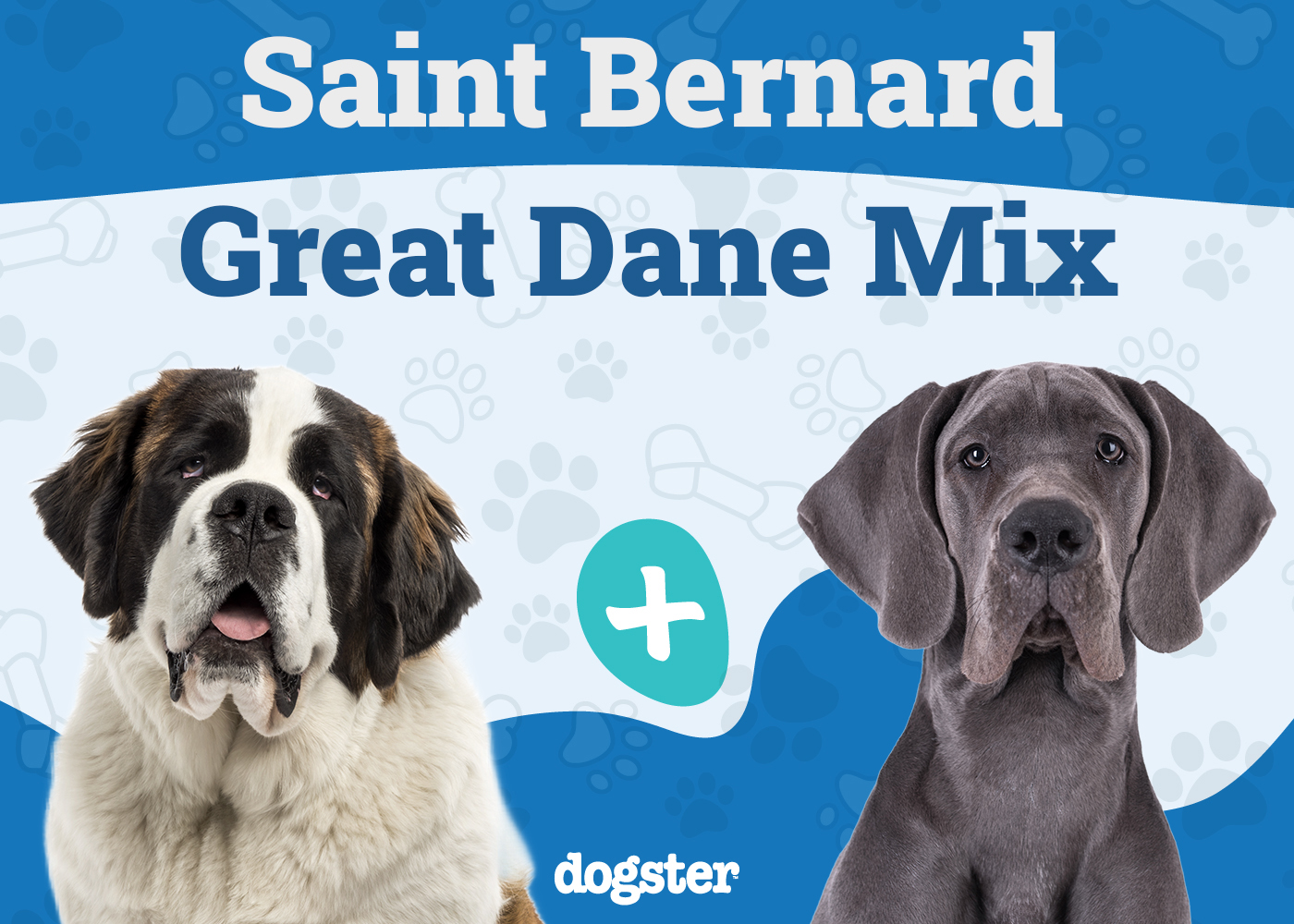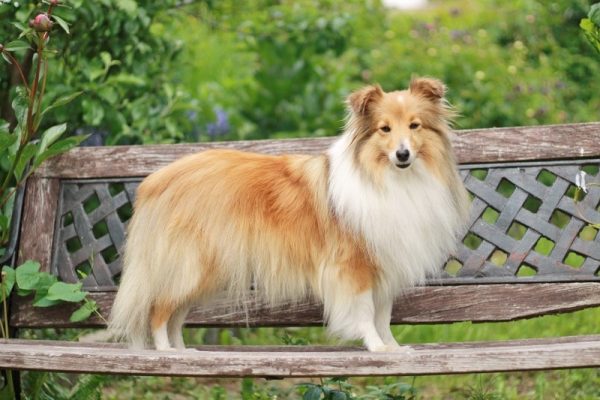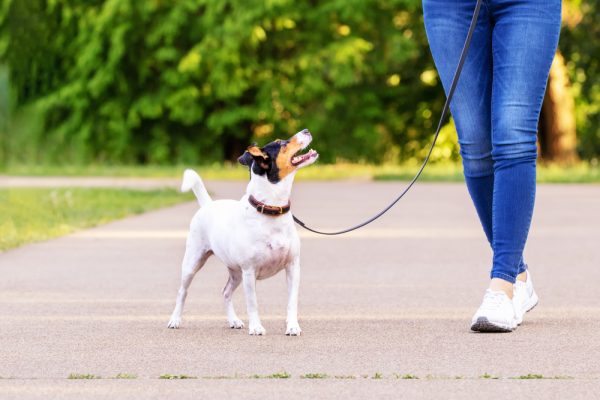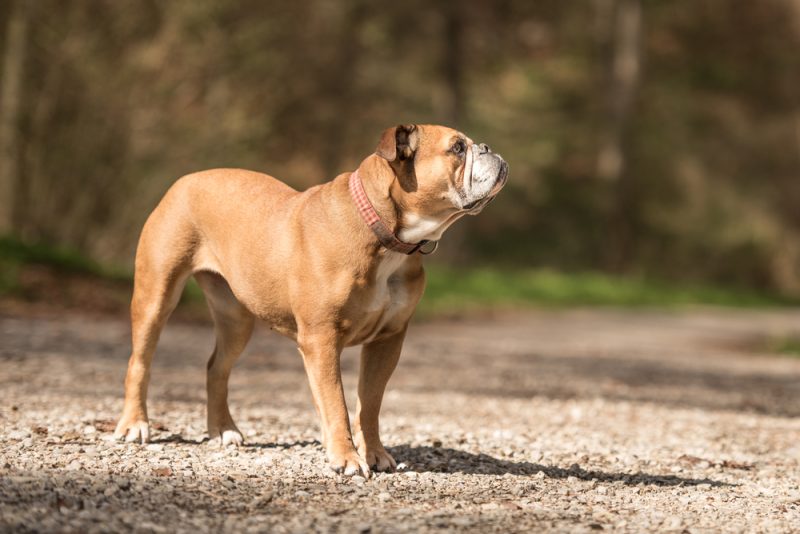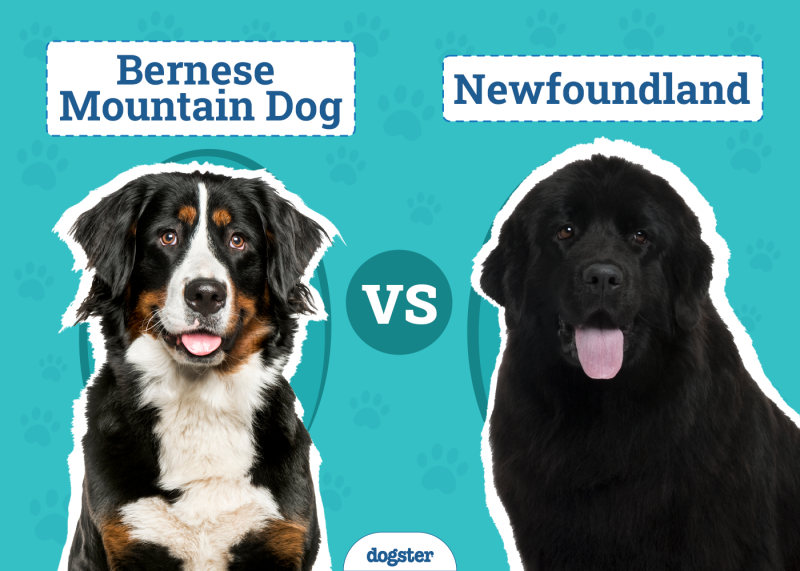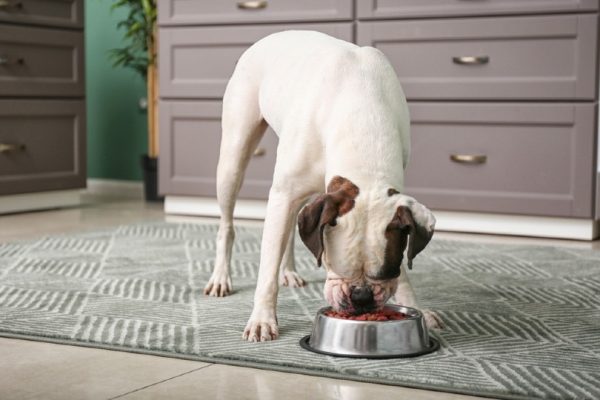In this article
View 8 More +Have you ever thought about getting a Great Dane or a Saint Bernard but not sure which one to get? Do purebred prices scare you off? If this is you, then look no further than the Saint Dane.
Saint Danes are a mix of the Great Dane and Saint Bernard, hence the clever, mixed name. They are also known as Great Bernards or Bernadanes. They are big like their relatives and have the same loveable and gentle qualities. This St Bernard Great Dane mix are good with children, other pets, and are loyal and affectionate with their families.
Breed Overview
Height:
25 to 32 inches (male), 20 to 30 inches (female)
Weight:
160 to 200 pounds (male), 155 to 195 (female)
Lifespan:
6 to 10 years
Colors:
White, black, brindle, and fawn
Suitable for:
Active families, families with children, families with other pets, laid-back families
Temperament:
Loyal, intelligent, affectionate, easy to train, gets along with other pets
Great Danes were bred for hunting, while Saint Bernards were bred for search and rescue. Combining these two traits along with the loving, gentle, and affectionate disposition makes for a joyful addition to your family. If you want a huge, loveable dog, this mixed breed may be for you; this guide will help you to determine for sure. Read on to learn everything there is to know about this loving and loyal breed.
Saint Dane Characteristics

Saint Dane Puppies
Saint Dane puppies will grow into the big, 155 to 200-pound dogs in adulthood. Because of their huge size, apartment living is not recommended. They will need daily exercise, so a fenced yard is ideal. They do fine being alone and will chill with you if you want to be lazy. They also drool a lot and shed, but brushing at least four times a week can help keep shedding down. As for the drool, that’s something you’ll have to accept. Also, keep in mind that they have a short lifespan of 6 to 10 years.
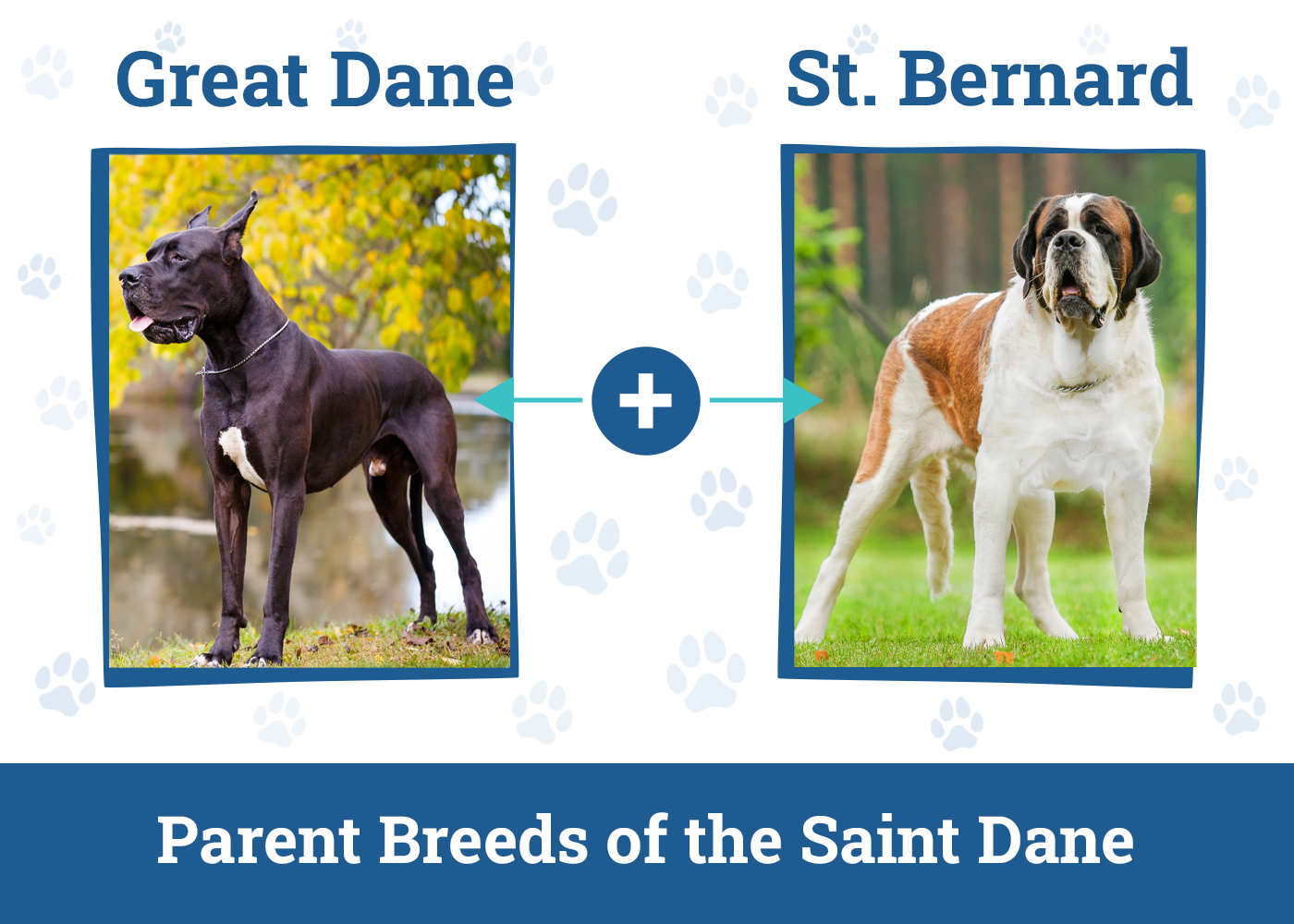

Temperament & Intelligence of the Saint Dane 🧠
Saint Danes are smart, loyal, affectionate, and loving. Great Danes and Saint Bernards are two very intelligent breeds; it’s no wonder Saint Danes follow in their parents’ footsteps. They are tenderhearted and love to lay around with you. They do best with positive reinforcement and given their large size, they can look intimidating to ward off any unwanted strangers, making them an ideal watchdog. They are easy to train and love being around their humans, whether you’re outside playing with the kids or just relaxing.
Are These Dogs Good for Families?🏡
Saint Danes are terrific for families. They love children, but you’ll want to take heed during playtime. The Saint Dane doesn’t recognize its own strength and may knock a child down by accident due to its enormous size. Rest assured, they will feel bad about it and give lots of love afterward, more than likely with slobbery, wet kisses.
Given their tenderhearted nature, they are protective of their humans, and a deep, threatening bark may accompany a new person entering the home. Once the Saint Dane realizes the new person is friendly, it doesn’t take them long to show affection.
Does This Breed Get Along with Other Pets? 🐶 😽
If you already have other pets (cats, other dogs), the Saint Dane will befriend them quickly. They are not known to chase smaller animals due to their Saint Bernard ancestors, but it’s always wise to slowly introduce new pets to one another. If you have a smaller dog, a Saint Dane’s size might be intimidating, but with their big heart, your little dog will feel at ease quickly.

Things to Know When Owning a Saint Dane
Food & Diet Requirements 🦴
With their big size comes a big appetite. Be prepared to feed your Saint Dane anywhere from four to six cups of dry kibble daily. The amount will depend on the size of your Saint Dane. When your Saint Dane is a puppy, they may need even more. We also recommend dividing up the feeding times throughout the day.
When searching for quality dog food, try and find a formula for large breed dogs and one that lists a quality protein first, like real chicken. Also, find one with no gluten, soy, or wheat and that has no artificial flavors or preservatives. The food needs to have plenty of vitamins, minerals, and vegetables for a balanced diet.
Exercise 🐕
Saint Danes love to exercise, but it’s important not to over-exert them, especially in the hot summer months. These dogs can be prone to obesity due to their laid-back nature, so try to aim for at least 45 minutes of exercise daily. For puppies, try walks in your neighborhood before aiming for any prolonged activity.
It’s ideal to have a fenced yard, so your Saint Dane has plenty of room to run. When playing outside, make sure they have access to plenty of water to avoid dehydration. If you live in an apartment or have no backyard, the St Bernard Great Dane mix is not suitable for you.
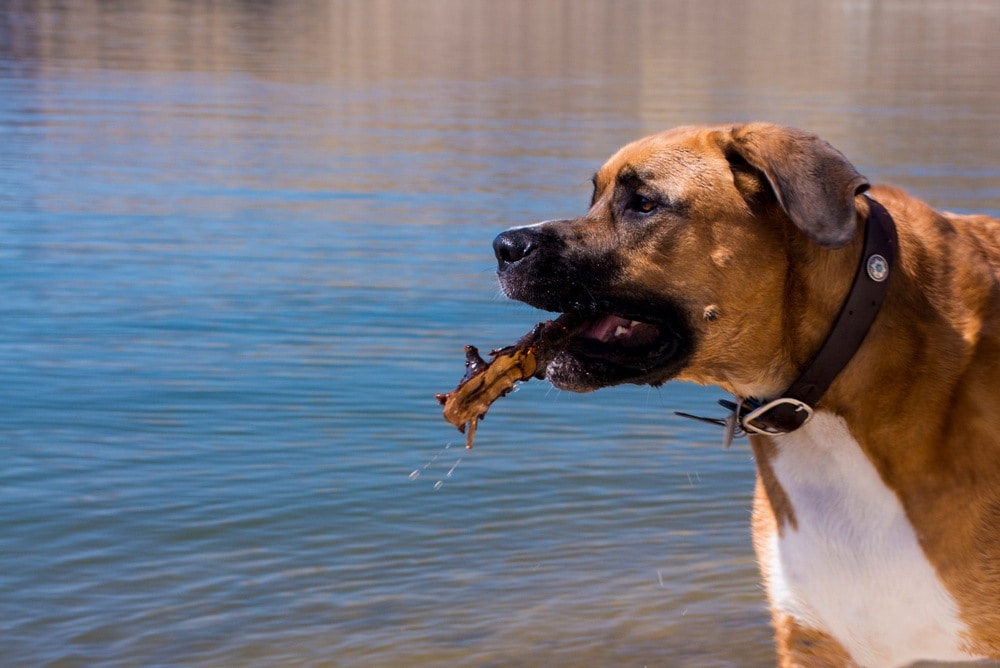
Training 🎾
With their Great Dane and Saint Bernard ancestry, these dogs are highly intelligent and easy to train. We’ve mentioned how they love to please their humans, which makes training even easier with this breed.
We’ve also mentioned how sensitive these dogs can be, so positive reinforcement is key to successful training. If you shout at your dog, they will become afraid of you. Instead, use a firm approach and be consistent; it won’t take long for them to realize when they’ve done something unacceptable, like jumping on people or not sitting when told. Make sure you reward your pup for good behavior. In doing so, you’ll have a well-behaved gentle giant.
Grooming ✂️
If you’re still reading, you know that these dogs shed a lot. You’ll want to brush them about four times a week to keep shedding to a minimum. It’s best to start this grooming routine in the puppy stage. Adult Saint Dane dogs can be stubborn when it comes to this activity, but if you introduce it early, they’ll sit and let you brush away.
Health and Conditions 🏥
Any large breed has certain health conditions to be aware of, and the Saint Dane is no exception. Given their short life spans of 10 years at their healthiest, here are a few conditions to watch out for.
- Entropion
- Gastric Torsion
- Cardiomyopathy
- Hip and Elbow Dysplasia
- Myotonia
Minor Conditions:
- Entropion: A treatable condition that requires surgery. The eyelid rolls inward, causing irritation to the cornea.
Serious Conditions:
- Gastric Torsion: Also known as bloat or gastric dilation volvulus (GDV). It’s a condition where the stomach twists. It mostly occurs in deep-chested dogs, and the reason is largely unknown. Watch out for breathing problems, anxiety, or a distended stomach. If you notice these symptoms, contact your veterinarian immediately.
- Cardiomyopathy: A disease brought on by an enlarged heart. This condition mainly occurs in large breeds of dogs and is the most common cause of heart failure.
- Hip and Elbow Dysplasia: A painful, skeletal condition that mostly occurs in large breeds. This condition is hereditary, and large breeds are predisposed to it. Dysplasia happens when the joint sockets grind together. Poor nutrition and improper diet can lead to dysplasia.
- Myotonia: A rare muscle disease that is usually hereditary, especially in Great Danes. A good breeder can avoid this predisposed condition by eliminating any affected parents for the breeding pool.
Male vs Female
A big (no pun intended) difference is the males are larger than the females. Males can weigh up to 200 pounds, while females average around 195 pounds max. Males also are taller (25 to 32 inches) than females (20 to 30 inches). When it comes to personality, the difference between males and females is negligible, especially if your dog has been spayed/neutered.

3 Little-Known Facts About the Saint Dane
1. They are known as a “designer dog breed.”
Designer dog breeding has been around for about three decades or so. Saint Danes are among the popular designer dog breeds, such as the Goldendoodle (Golden Retriever and Poodle), Labradoodle (Labrador Retriever and Poodle), and a Puggle (Pug and Beagle), just to name a few.
2. They are sensitive dogs.
Despite their enormous size, Saint Dane dogs are sensitive to yelling or loud scolding. This type of behavior will stress the dog out, and they may even become afraid of you. Positive reinforcement is best for training these gentle giants, as with any dog, and they are eager to please you.
3. They shed and drool—a lot.
If dog drool or dog hair grosses you out, then this breed may not be for you. They are known for their ability to have constant drool, so be prepared to have slobber on your hands, clothes, and furniture— really, pretty much anywhere they go. Their short, straight hair constantly sheds, so be prepared to groom regularly. Your vacuum will also get a workout.

Final Thoughts
Now that you’re aware of these large, loveable dogs, there are a few things to consider before seeking one out. They have short lifespans with a maximum of 10 years, and you need a good-sized yard for them to run and play. They require regular brushing, and you’ll need to prepare for a vast amount of daily drool.
Despite their shortcomings in the health and grooming department, they make wonderful companions and have hearts of gold. Their size and deep bark make for an excellent watchdog, and they will go to great lengths to please its humans. All dogs deserve a great life, no matter the expected lifespan. And if you want a dog that will give you cuddles, slobbery kisses, and love you to the moon and back, a Saint Dane is the dog for you.
See Also:
- Saint Shepherd (Saint Bernard German Shepherd Mix): Care, Pictures, Info & More
- St. Bullnard (St. Bernard Pitbull Mix): Care, Pictures, Info, & More
